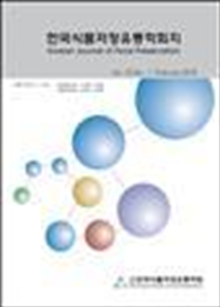간행물
한국식품저장유통학회지 (Korean J. Food Preserv.) KCI 등재 SCOPUS 한국식품저장유통학회지 The Journal of Korean Society of Food Preservation

- 발행기관 한국식품저장유통학회
- 자료유형 학술지
- 간기 연7회
- ISSN 1738-7248 (Print)2287-7428 (Online)
- 수록기간 1994 ~ 2018
- 주제분류 농수해양 > 식품과학 농수해양 분류의 다른 간행물
- 십진분류KDC 521DDC 630
권호리스트/논문검색
제7권 제1호 (2000년 3월) 24건
21.
2000.03
서비스 종료(열람 제한)
Comparison of Chemical Compositions of Houttuynia cordata Thunb Cultivated from Different Local Area
Proximate composition , volatile compounds, free amino acids, fatty acids and inorganic compounds in leaf, stem and root of Houttyunia cordata Thunb cultivated from two different area, Bosung and Sunchon , were analyzed. Each part of Houttuynia cordata Thunb from both local area showed moisture contents of 80-84% and crude ash contents of 2.1 ∼2.8%. Crude fat and protein contents were less than 3 % showing slightly higher contents in leaf than in both stem and root . Twenty six volatile compunds were identified from the parts of the plant, the volatile contents were high in the oder of leaf, root and stem. Major volatile compounds were mostly derivatives of decanoic acid ; decanoic acid, 20 tridecanoie, decanal and dodecanoic acid. Of free amino acids in leaf asparagine was the highest, while in stem hydroxyproline, proline and arginine were the major free amino acids. Linoleic acid was the highest in the stem and root, and linolenic acid was highest in leaf. the major minerals of all parts were K, Ca. Mg, P, Fe, Zn and Cu, showing highest with K.
22.
2000.03
서비스 종료(열람 제한)
한국산 작두콩을 종자, 자엽 및 껍질로 구분하여 항균활성성을 조사하였다. 용매별 추출수율은 껍질이 다른 부위에 비해 물과 메탄올 추출물에서 높게 나타났으며, 메탄올 추출물의 계통분획별 추출수율은 물 분획 층에서 종자 3.3%, 자엽 2.5%, 껍질 0.3%로 높게 나타났다. 작두콩의 부위별 추출물의 항균활성은 용매별 추출물에서는 메탄올 추출물이 높게 나타났으며, 계통 분획 추출물에서는 에칠 아세테이트 분획층에서 종자, 자엽, 껍질 모두 항균활성이
23.
2000.03
서비스 종료(열람 제한)
In order to promote the utilization of Hovenia dulcis leaf as food, leaf tea was nanufactured and its physicochemical properties were examined. Aong proximate composiotns of Hovenia dulcis leaf tea were found in both fermented tea and roasted tea the higher contents of total sugar and crude protein. In minerals component of fermented tea and roasted tea, potassium (K) was the most high amounts of 11,560.6 ppm and 11,084.6 ppm, respectively. The highest contents of free sugar in both teas were mainly consisted of sucrose, the amounts of sucrose showed 1.47% and 1.94% . In case of organic acids, oxalic acid and citric acid were revealed 631.26mg% and 660.05mg%, respectively. The highest contents of total amino acid in fermented tea and roasted tea were 812.01mg% and 709.72mg% of glutamic acid. the fatty acids of fermented tea and roasted tea were mainly composed of 40.18% of linolenic acid and 26.92% of palmitic acid, respectively. The major volatile compounds of fermented tea and roasted tea were composed of 3, 7, 11, 15-tertramethyl-2-hexadecen-1-ol and methyl palmitate and the amounts of those showed 290.1ppm and 472.97 ppm, respectively. The tannins of fermented tea and roasted tea were 1.02% and 1.26% , as the extraction steps increased the tannin contents decreased. In Hunter's color values of tea extract L and b values decreased , while a value of those increased as the extraction steps were repeated.
24.
2000.03
서비스 종료(열람 제한)
Antibacterial activities of powdered spices(garlic , ginger, cinnamon and clove) against pathogenic Escherichia coli )157:H7 and Staphyloccus auresus were investigated. Spice powder was added in was exponetial phase of each bacterial culture . Growth inhibition was determined by the absorbance at 660nm and morphological changes of the cells were observed by transmission electron microscope (TEM). Ginger powder has the highest antibacterial activity, following cinnamon , clove and garlic has the least activity.Growth of Escherichia coli O157:H7 and Staphyloccus aureus were completely inhibited within 5 hours after addition of 1 % of garlic , 0.3% of ginger or cinnamon , 0.5% of clove powder on the exponential phase of the cells. Spice untreated cells of E. coli and S. aureus, the cytoplasm was entirely surrounded by rigid cell wall and cell walls formed a smooth layer well attached to the plasma membrane. In the cells of E. coli and S. aureus treated with spice powder, cell wall and plasma membrane were lysed and severely damaged. E.coli cells growth in the presence of spice powder showed plammolysis, the loss of electron dense material, the formation of extra cellular blebs and cytoplasm burst out from the cell. S .sureus cells grown in the presence of spice powder showed swell of cell wall, the loss of electron dense material , coagulation of cell cytoplasm and formation of extra cellular blebs. Severely damaged cells of S. aureus lost whole cytoplasm and left as ghost of the cell. Spice powder stimulated autolyssi and induced cell death.
1
2

